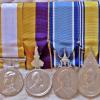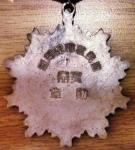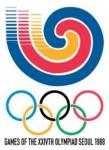-
Posts
249 -
Joined
-
Last visited
Content Type
Profiles
Forums
Blogs
Gallery
Events
Store
Everything posted by Archer
-
I am spending a coupla weeks in December in the Republics of Cambodia and Vietnam on the usual tourist trail, but if I can slip off the leash does any kind member know where I can buy medals in Phnom Penh or Siem Reap and HCM (Saigon) City and Hanoi? Your advice would be most welcome. Please steer me away from all forgers, fakers and rip-off artists. Thanks in advance William
-

Austria-Hungary Sources of good Austrian awards
Archer replied to dond's topic in Austro-Hungarian Empire
http://gmic.co.uk/index.php/topic/47151-collecting-medals-in-vienna-and-prague/page__hl__vienna__fromsearch__1 -

Bronze Star ... design stolen?
Archer replied to Chris Boonzaier's topic in United States of America
Italian Partisan's Star - presumably modelled on the US Bronze Star. Pity about the drawing pins -
NB Subr = Naib Subadar - equivalent rank of the old Jemadar. William
-
No - I think that is very unlikely, Chris. We are taking about a medal distributed by a voluntary committee in a provincial town - not an official award designed, struck and paid for by the government of the country. The quality of the medallion would have been governed by the funds available to the committee. They quite possibly used what money was left over when they shut down after the war, to strike these medals. (You may be forgetting just how small the population was, and how few the resources were, in the South Africa of 1918.) The violet ribbon looks contemporary. The colour is surely significant. I will concede that medals may also have been given to committee members and others, but somehow I doubt they would have been on violet ribbons. Lastly, let me repeat, Chris, we do know the Committee published at least two lists of the dead [see above]. Cheers! William
-
I was lucky enough to acquire a group of medals recently which included the medal of the Durban Recruiting Committee. At the time of writing there are very few references to this Committee, or its medal (or medallion), online. There is a reproduction of a recruiting poster bearing the rubber stamp of the Committee, bearing date 9 October 1918, at the Imperial War Museum site (http://www.vads.ac.u...e.php?uid=29576). Dix Noonan Webb sold a medal as part of a job lot on 5 March 1996, as follows: "South African National Memorial 1914-1918, ‘For their Faith and for Freedom they Died’, bronze plaque by Alfred Turner, 100 x 73 mm, in fitted presentation case; together with small 9 carat gold medal ‘In celebration of the Union forces in South Africa 1915; Pretoria Citizens Service Medal 1914-19, bronze; Durban Recruiting Committee, bronze medal, and Johannesburg Peace Celebration medal (4), one in silver, the remainder bronze, very fine to extremely fine (8)". The lot sold well above estimate. JK Militaria (http://www.jkmilitar...om/Miscell.html) is offering a medal for sale, suspended from a red/white/blue medal as follows: "South Africa, 'Pro Patria' (for Fatherland) WW1 Durban Recruiting Committee medal. Medal in bronze. Interesting design with Springbok head. Ribbon appears original. 26mm in diameter." The medal I have came with the WW1 pair to Conductor Percy McEvoy Wheeler of the South African Service Corps. Wheeler was a 43 year old farmer from Sarnia in Natal, roughly ten miles inland from central Durban, as the crow flies. He volunteered for full-time military service and was formally attested into the Army in Durban for service with the South African Imperial Service Units on 19 February 1917. He stated quite clearly that he had had no previous military experience and it seems he was needed for a specialised role best-suited to a Natal farmer - to be a conductor with the animal transport in East Africa. Five days after joining up, and with barely any exposure to military training, lore or customs, he embarked at Durban bound for East Africa aboard the transport Clan McPhee. South African medal collectors will tell you that the greatest enemy our men faced in East Africa was not General von Lettow Vorbeck (brilliant though he was), but malaria and other tropical diseases. On 21 April 1917 - less than two months after arriving in the theatre - Wheeler reported sick suffering with malaria, and was admitted to No. 14 South African Casualty Clearing Station in Dodoma. But unlike fitter and younger soldiers who often emerged shattered but alive from an encounter with the female Anopheles mosquito, Wheeler was untrained, so presumably unfit, and 43 years old. He died the next day. The Durban Recruiting Committee Medal found with his medals is suspended from a violet coloured ribbon. Violet is, traditionally, a colour of mourning. I cannot say with certainty that the Medal was only given to families of men killed or died on service, but we do know the Committee published at least two lists of the dead (see http://www.google.co...MITTEE%22&btnG=), and in light of the ribbon, I feel safe to say that this little medallion, although unofficial, enjoys something of the status of the Memorial Crosses of Canada and New Zealand. William Here is a picture of the obverse.
-
Dafadar Waryam Singh, 40th Cavalry The regiment was raised in April 1918 by Lieutenant-Colonel J.R. Gaussen, 3rd Skinner’s Horse, from one squadron of the 1st (DYO) Lancers (Skinner’s Horse), two squadrons of 3rd Skinner’s Horse, and one squadron of the 7th Hariana Lancers. It was designated as the 40th Cavalry, and served on the North-West Frontier. Col. Gaussen apparently continued to command the regiment even after being appointed to the command of 3rd Skinner’s Horse in October 1918. * According to the Quarterly Indian Army List for January 1919, the regiment comprised 1½ squadrons of Mussalmans, one squadron of Rajputs, a half squadron of Jats, a half squadron of Sikhs, and a half squadron of Dogras. The Regiment was disbanded in 1921. * Brigadier-General James Robert Gaussen, C.M.G., C.I.E., D.S.O. (born in 1871), served in the relief of Pekin in 1900 (wounded; mentioned in despatches; awarded the China Medal and clasp and created D.S.O.); in France, 1916-1917 (commanding a battalion of South Wales Borderers; twice mentioned in despatches; awarded the British War and Victory Medals and created C.M.G.); on the North West Frontier in 1918 (commanding 3rd Skinner’s Horse; raised 40th Cavalry in April 1918; wounded; mentioned in despatches; created C.I.E.); and in the third Afghan War in 1919 (commanding 40th Cavalry; awarded the Indian General Service Medal and clasp). He served as Brigadier-General commanding the forces in East Persia, 1919-1920, and retired in 1921.
-
Medals still (ahem!) in my custody Pala Singh, Sowar, 3rd Skinner’s Horse In September 1914, 3rd Skinner’s Horse was allocated to the Meerut Cavalry Brigade, which was formed under Brigadier-General J.B. Edwards, D.S.O., as a unit of the 2nd Indian Cavalry Division. The Division sailed from Bombay on 19 November 1914, and arrived at Marseilles in France on 14 December 1914. At times during the months that followed it served in the trenches as infantry, each Cavalry Brigade once dismounted forming a dismounted regiment. The Indian Cavalry Corps, formed in France in December 1914, was broken up in March 1916 and the Meerut Cavalry Brigade left the 2nd Indian Cavalry Division in June 1916. 3rd Skinner's Horse returned to India and proceeded to Baluchistan, where it won fame in February 1918 when 80 men of the Regiment defended the Gumbaz Post against repeated attacks by tribesmen. Lieutenant-Colonel J.R. Gaussen, C.M.G., D.S.O., who was appointed to raise and command the 40th Cavalry in April 1918, succeeded to command of 3rd Skinner’s Horse, but remained with the 40th Cavalry, in October 1918. Lieutenant-Colonel J.H. Bennett officiated in command while Colonel Gaussen was away from the Regiment. The Regiment “put up a good show” in the 3rd Afghan War. Besides acting Lieutenant-Colonel Vere Arthur Coaker, mentioned in despatches and created companion of the Distinguished Service Order, six men were mentioned in despatches for their services: Lieutenant-Colonel E.C.W. Conway-Gordon (on the commands and staff and miscellaneous list); Capt. H.H. Lyons, M.C.; Jemadar Bhagwan Singh; 1450 Daffadar Gurdiyal Singh; 1691 acting Lance-Daffadar Pritam Singh and 2546 Sowar Chajja Singh. Lieutenant-Colonel E.C.W. Conway-Gordon succeeded to command of the Regiment in 1921. The 1st Bengal Lancers and 3rd Skinner’s Horse were amalgamated to become Skinner's Horse (1st Duke of York's Own Cavalry) in 1922.
-

Ribbon bar question
Archer replied to Noor's topic in Great Britain: Orders, Gallantry, Campaign Medals
Don't get me started on one of my hobby horses! The real world is NEVER as clear cut as collectors believe it is or should be. You are ENTITLED to wear a black silk ribbon with a silver Maltese cross on it to indicate membership of the Order. If you don't have a cross or don't have a tailor who knows what he's doing you might possibly wear a plain black ribbon. I don't know about white crosses. Please put up a photograph if you have one. I am a Commander of the Order. Here is my ribbon bar. Note the "white" in the cross is cotton thread holding the cross in place on the ribbon. In some lights the cross looks dark grey rimmed with silver! -

Ribbon bar question
Archer replied to Noor's topic in Great Britain: Orders, Gallantry, Campaign Medals
Yes ... more or less! * Ribbon denoting membership of the Order of St. John (any grade) * Defence Medal * Service Medal of the Order with two bars (one cross missing) denoting in the UK a total of 15 + 5 + 5 (total 25) years' service, and in (some) overseas brigades 12 + 5 + 5 (total 22) years' service. Check out my gallery for some nice groups. William -
Are you meddling in this thread, too? :lol: :lol: :beer:
-
And finally a ribbon bar, attached at the back of the Olympics Medal - the recipient's full-sized medal was unfortunately not with it. Any idea what it is? First Aid ... ?
-
TO ADD TO THIS OLD THREAD ... Bought in Seoul and cleaned up in a mild acid solution, here is the People's Republic of China's take on the Nationalist Chinese Order of the Sacred Tripod. Apart from the clunking heavyness and flat finish, the obvious give-aways are: * the communist-style ribbon - with * completely wrong colour combination, * the shabby and inadequate split ring at the suspender (it's a bit of wire), and * the People's Republic-type reverse mounting pin. I hope the Chairman doesn't toss me out if I say I am really enjoying playing with such an obvious "dud" - I can wear it around town and not even be a walt, just a fantasist. Alternatively I've thought of using it as a keyring, or a garden ornament! William
-
The medal was obviously awarded for meritorious contributions in connection with the Seoul Olympics of 1988. Note the design of the obverse roundel of the medal - featuring a samtaeguk pattern - and the colour choice for the ribbon.
-
-
Second the Olympics medal. Note the top bar (taken in different lighting conditions) Any member who can read Korean please provide us with an English translation of the inscriptions.
-
OK - the aeroplane has landed and the medals are safely home. Here are some better photographs, Hugh. First the 40th Anniversary of the Republic of Korea Armed Forces Medal. Note the western style number 40, and the motif including wings and anchor. Sources refer to this as an Army medal, but it can only be an Armed Forces medal.
-
Ahhh ! I thought so, but wasn't sure! Thanks William
-
What is it a copy of?
-
Thanks greatly! The shopkeeper said something about the Olympics?
-
















